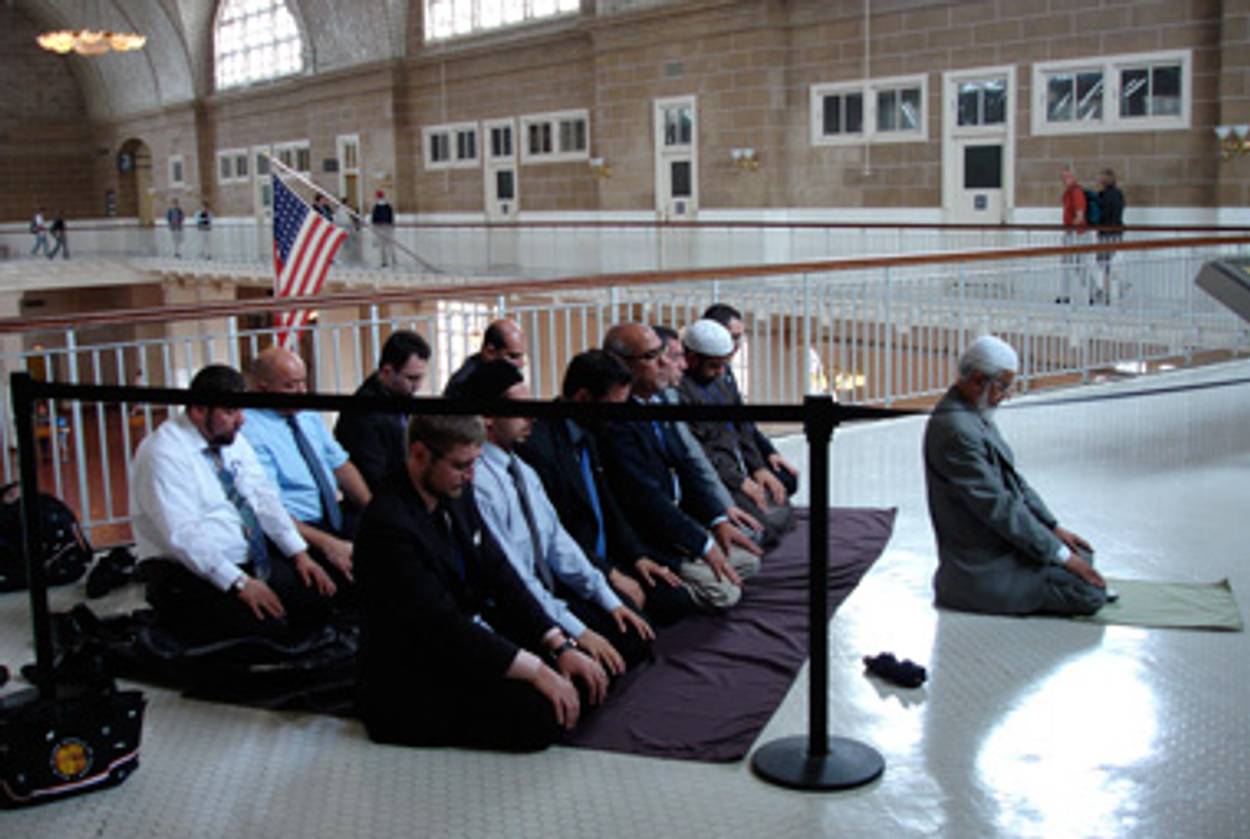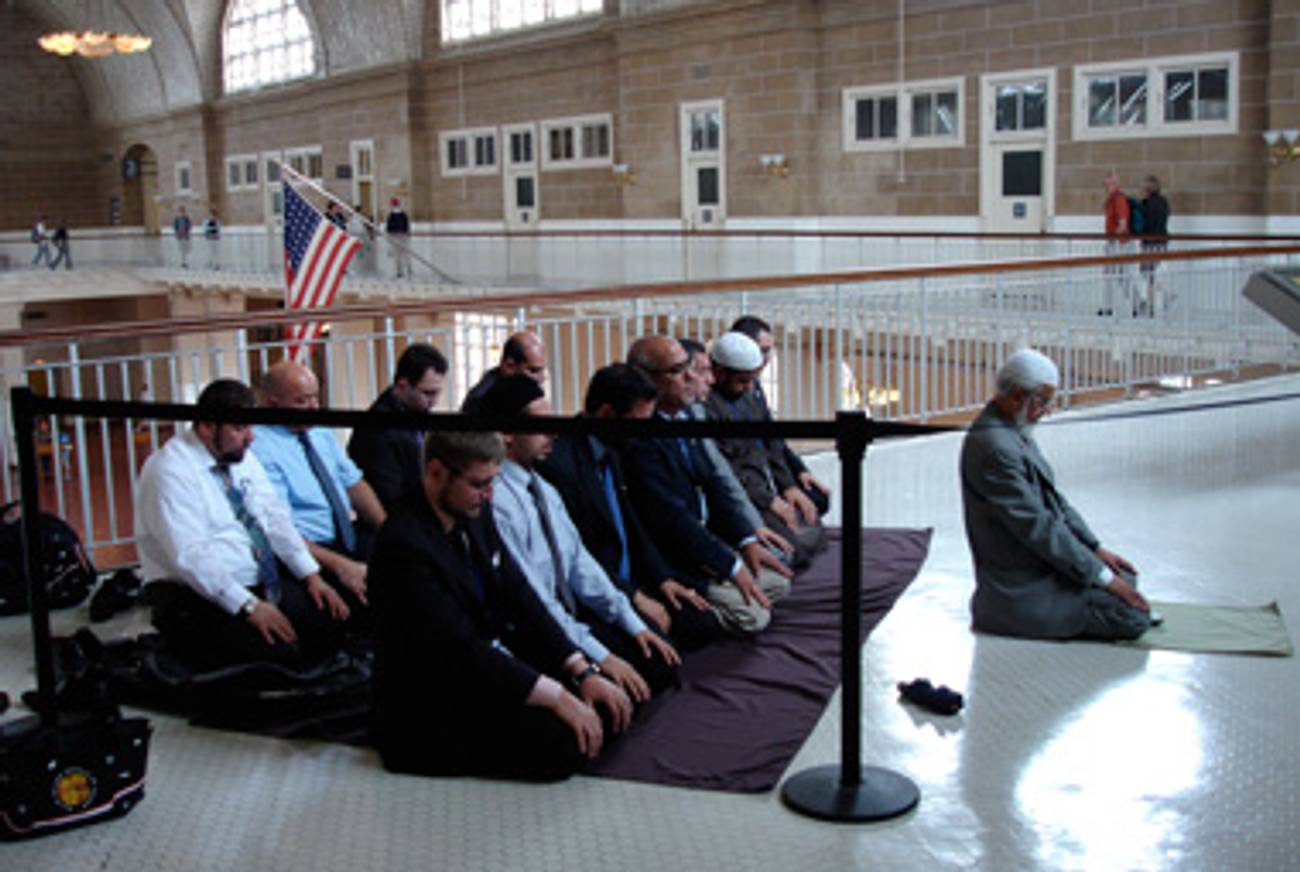Shalom, and Salaam
European rabbis and imams pay a visit to Ellis Island




It was pouring rain yesterday morning when a delegation of European rabbis and imams, visiting New York and Washington on a four-day interfaith mission to the United States, arrived at the Coast Guard station in Lower Manhattan for a tour of Ellis Island. After a half-hour wait huddled beneath umbrellas outside the security shack—where officials conducted special ID checks on the imams—the group boarded their launch, jackets and trousers somewhere between damp and sodden. Some insisted on seeing the bright side, giving thanks to God for keeping the sun shining at least for their outing to Yankee Stadium the night before. “It adds an element of realism to it,” said Imam Shahid Hussain, of London’s Central Mosque, as he disembarked the boat. “Not everyone who immigrated here got to arrive in bright sunshine.”
Hussain was one of only a handful of imams making a return visit to the transit point for millions of European emigrés; most of the rabbis said they had been there before, either on previous official visits or as tourists. This trip was sponsored by the Foundation for Ethnic Understanding, a New York-based non-profit headed by Rabbi Marc Schneier and chaired by hip-hop impresario Russell Simmons, who did not put in an appearance. It was intended to remind the Muslim delegates of American Jews’ experience as immigrants and outsiders; most of the imams had been recruited for their prior interfaith work by rabbis from their home countries, which included Belgium, France, Italy, Germany, the Netherlands, Norway, Russia, and Switzerland. Organizers hoped the clergy would consider “twinning” programs between the synagogues and mosques upon their return home.
One of the participants translated from English into Arabic as a National Park Service docent led the group through the Ellis Island Chronicles, a series of rooms containing dioramas depicting the island’s development. Walter Ruby, a program organizer, interrupted to tell the group that his own mother, who fled Berlin via France and Portugal at 16, had been detained on the island for two weeks in 1941, while his grandmother searched New York for someone to sponsor their visas. “She celebrated Passover here,” Ruby said. “She figured it wasn’t so bad because at least she wasn’t going to be killed by the Nazis.” There was a wave of sympathetic laughter.
Imam Abdelali Mamoun, from the Clamart Mosque near Paris, seemed struck by the tale, and he asked Ruby, in broken English, about his mother’s journey to America. Mamoun, who was on his first trip to the United States, said he hadn’t heard the stories of European immigrants processed through Ellis Island before; what he did know about was how badly the colonial Europeans had treated the native Americans. “They put away the local people,” said Mamoun, who explained in voluble Arabic that he, as the son and grandson of French Algerians, identified more with the colonial story than the immigrant narrative. Muzammil Siddiqi, the director of the Islamic Society of Orange County, in Southern California, stepped in to translate, and he pointed out that Ellis Island did mean something to older Muslims in Detroit, whose grandparents made their way through the Ellis Island portal a century ago. By the time he arrived from India, to study at Harvard, he continued, that era was long gone. “When I came here 40 years ago, I just went to Logan Airport,” he said, shrugging.
The visiting rabbis also had a hard time feeling connected to a place they associated with the American experience. “Look, everyone in America is a part of this story—everyone in America owns a piece to the tile on this floor,” said Rabbi Reuben Livingstone, of the Hampstead Garden Synagogue in London. “There is no place in Europe that can embody that.”
After a stop in the Great Hall to peer at photocopied ship manifests, the group made their way up to a balcony, where caterers had set up an elaborate buffet of kosher grilled chicken, roast vegetables, and salad. “Jewish food, it’s very nice!” commented one imam, surveying the determinedly non-ethnic spread. Over at the bar, a server poured from a selection of soda, sparkling water, and Snapple; a bottled of chilled Australian Chardonnay was produced. One of the rabbis inspected it, turning it over in his hands to see if it carried a hechsher. “Is it kosher?” asked Imam Mamoun, who was getting a refill of Coca-Cola. “I don’t think so, it doesn’t say,” the rabbi said mournfully, handing it back to the server.
The group moved into a reception room lined with the flags of all the nations represented to eat, a parade of speakers addressed questions of how Jews and Muslims could communicate over immigration issues; several closed with “Shalom, and salaam,” drawing murmurs of approval from the imams, many of whom spoke very little English. After the meal, it was time for prayers, or almost time. The rabbis determined it was too early for davening the afternoon mincha prayers and returned to their coffee and cakes. “It is always the halachic problem of when to daven mincha—can the Muslims daven with us, you know?” joked Rabbi Raphael Evers, of Amsterdam. The imams, meantime, cleared space on the balcony of the Great Hall and turned toward Mecca. The leader began calling the prayers, in a stentorian voice that echoed off the vast tiled arches and silenced the startled visitors below.
Then it was a rush back to the waterfront, in order to make a 2 o’clock meeting with Mayor Michael Bloomberg. The delegates boarded the Miss Liberty, toting gift bags filled with Ellis Island baseball caps and other goodies (though Rabbi Pinchas Goldschmidt, Chief Rabbi of Moscow, was loyal to the Yanks, perching a navy-blue ballcap atop his head to keep the rain off). They smiled for photos on the deck, as the Statue of Liberty slipped behind their heads.
Allison Hoffman is a senior editor at Tablet Magazine. Her Twitter feed is @allisont_dc.
Allison Hoffman is a senior editor at Tablet Magazine. Her Twitter feed is @allisont_dc.